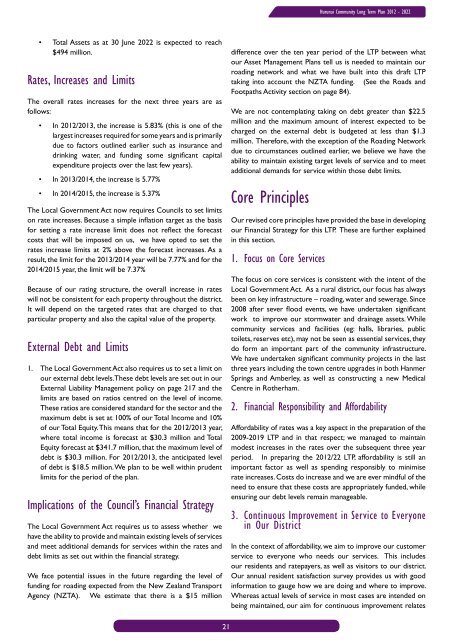LTP 2012-2022 - Introduction - Hurunui District Council
LTP 2012-2022 - Introduction - Hurunui District Council
LTP 2012-2022 - Introduction - Hurunui District Council
Create successful ePaper yourself
Turn your PDF publications into a flip-book with our unique Google optimized e-Paper software.
<strong>Hurunui</strong> Community Long Term Plan <strong>2012</strong> - <strong>2022</strong><br />
• Total Assets as at 30 June <strong>2022</strong> is expected to reach<br />
$494 million.<br />
Rates, Increases and Limits<br />
The overall rates increases for the next three years are as<br />
follows:<br />
• In <strong>2012</strong>/2013, the increase is 5.83% (this is one of the<br />
largest increases required for some years and is primarily<br />
due to factors outlined earlier such as insurance and<br />
drinking water, and funding some significant capital<br />
expenditure projects over the last few years).<br />
• In 2013/2014, the increase is 5.77%<br />
• In 2014/2015, the increase is 5.37%<br />
The Local Government Act now requires <strong>Council</strong>s to set limits<br />
on rate increases. Because a simple inflation target as the basis<br />
for setting a rate increase limit does not reflect the forecast<br />
costs that will be imposed on us, we have opted to set the<br />
rates increase limits at 2% above the forecast increases. As a<br />
result, the limit for the 2013/2014 year will be 7.77% and for the<br />
2014/2015 year, the limit will be 7.37%<br />
Because of our rating structure, the overall increase in rates<br />
will not be consistent for each property throughout the district.<br />
It will depend on the targeted rates that are charged to that<br />
particular property and also the capital value of the property.<br />
External Debt and Limits<br />
1. The Local Government Act also requires us to set a limit on<br />
our external debt levels. These debt levels are set out in our<br />
External Liability Management policy on page 217 and the<br />
limits are based on ratios centred on the level of income.<br />
These ratios are considered standard for the sector and the<br />
maximum debt is set at 100% of our Total Income and 10%<br />
of our Total Equity. This means that for the <strong>2012</strong>/2013 year,<br />
where total income is forecast at $30.3 million and Total<br />
Equity forecast at $341.7 million, that the maximum level of<br />
debt is $30.3 million. For <strong>2012</strong>/2013, the anticipated level<br />
of debt is $18.5 million. We plan to be well within prudent<br />
limits for the period of the plan.<br />
Implications of the <strong>Council</strong>’s Financial Strategy<br />
The Local Government Act requires us to assess whether we<br />
have the ability to provide and maintain existing levels of services<br />
and meet additional demands for services within the rates and<br />
debt limits as set out within the financial strategy.<br />
We face potential issues in the future regarding the level of<br />
funding for roading expected from the New Zealand Transport<br />
Agency (NZTA). We estimate that there is a $15 million<br />
difference over the ten year period of the <strong>LTP</strong> between what<br />
our Asset Management Plans tell us is needed to maintain our<br />
roading network and what we have built into this draft <strong>LTP</strong><br />
taking into account the NZTA funding. (See the Roads and<br />
Footpaths Activity section on page 84).<br />
We are not contemplating taking on debt greater than $22.5<br />
million and the maximum amount of interest expected to be<br />
charged on the external debt is budgeted at less than $1.3<br />
million. Therefore, with the exception of the Roading Network<br />
due to circumstances outlined earlier, we believe we have the<br />
ability to maintain existing target levels of service and to meet<br />
additional demands for service within those debt limits.<br />
Core Principles<br />
Our revised core principles have provided the base in developing<br />
our Financial Strategy for this <strong>LTP</strong>. These are further explained<br />
in this section.<br />
1. Focus on Core Services<br />
The focus on core services is consistent with the intent of the<br />
Local Government Act. As a rural district, our focus has always<br />
been on key infrastructure – roading, water and sewerage. Since<br />
2008 after sever flood events, we have undertaken significant<br />
work to improve our stormwater and drainage assets. While<br />
community services and facilities (eg: halls, libraries, public<br />
toilets, reserves etc), may not be seen as essential services, they<br />
do form an important part of the community infrastructure.<br />
We have undertaken significant community projects in the last<br />
three years including the town centre upgrades in both Hanmer<br />
Springs and Amberley, as well as constructing a new Medical<br />
Centre in Rotherham.<br />
2. Financial Responsibility and Affordability<br />
Affordability of rates was a key aspect in the preparation of the<br />
2009-2019 <strong>LTP</strong> and in that respect; we managed to maintain<br />
modest increases in the rates over the subsequent three year<br />
period. In preparing the <strong>2012</strong>/22 <strong>LTP</strong>, affordability is still an<br />
important factor as well as spending responsibly to minimise<br />
rate increases. Costs do increase and we are ever mindful of the<br />
need to ensure that these costs are appropriately funded, while<br />
ensuring our debt levels remain manageable.<br />
3. Continuous Improvement in Service to Everyone<br />
in Our <strong>District</strong><br />
In the context of affordability, we aim to improve our customer<br />
service to everyone who needs our services. This includes<br />
our residents and ratepayers, as well as visitors to our district.<br />
Our annual resident satisfaction survey provides us with good<br />
information to gauge how we are doing and where to improve.<br />
Whereas actual levels of service in most cases are intended on<br />
being maintained, our aim for continuous improvement relates<br />
21

















